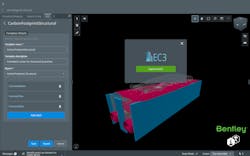Bentley Systems Integrates EC3 with iTwin Platform for Infrastructure Carbon Calculation
Infrastructure engineering software company Bentley Systems expanded integrated workflows for embodied carbon calculation in the Bentley iTwin platform.
The new integration enables carbon assessment in infrastructure digital twin solutions, empowered by the Embodied Carbon in Construction Calculator (EC3). Developed by the nonprofit Building Transparency, EC3 is a no-cost, open-access tool that allows benchmarking, assessment and reductions in embodied carbon, focused on the upfront supply chain emissions of construction materials.
Building Transparency provides the education, resources and tools – including EC3 – to address embodied carbon’s role in climate change. The EC3 tool and its subsequent effect on the industry are driving demand for low-carbon solutions and incentivizing construction material manufacturers and suppliers to invest in disclosure, transparency, and material innovations that reduce the carbon emissions of their products.
The EC3 integration allows Bentley’s infrastructure digital twin solutions, powered by iTwin, and third-party applications built on the Bentley iTwin platform, to simplify and accelerate the generation of carbon reporting and insights based on the no-cost, open-source EC3 carbon database and calculator.
The Bentley iTwin platform is an open, scalable, platform-as-a-service offering that enables developers to create and bring to market solutions that solve real infrastructure problems by leveraging digital twins.
Designers and sustainability engineers in the architectural, engineering, and construction industry spend a significant amount of time assessing or reporting on the environmental footprint of infrastructure projects, mainly when manually exporting and aggregating data from quantity counts and bills of materials.
It can also be error-prone, requiring additional verification of successful ingestion by carbon tools. Moreover, AEC professionals do not want to be locked into one single carbon calculator as different calculators may provide different results (for instance, due to uncertainties in environmental product declarations), and carbon reporting and certification requirements differ as a function of the project, country, or infrastructure owner.
The added integration with EC3 not only creates time savings with improved accuracy but also provides uncertainty estimations of the EPD data and increases carbon transparency due to Building Transparency’s open-source/open-access strategy. Users can incorporate engineering data created by various design tools into a single view using the Bentley iTwin platform, generate a unified report of materials and quantities, and share it with different carbon analysis tools – now also with EC3 – via cloud synchronization.
One of the mutual users interested in this new integration is WSP, applying both the EC3 database and the Bentley iTwin platform on infrastructure projects such as the Interstate Bridge Replacement program.
About the Author
T&D World Staff
Content Team
Nikki Chandler
Group Editorial Director, Energy
[email protected]
Jeff Postelwait
Managing Editor
[email protected]
Christina Marsh
Senior Editor
[email protected]
Ryan Baker
Associate Editor
[email protected]
Amy Fischbach
Electric Utility Operations
[email protected]
Rich Maxwell
Community Editor
[email protected]
Gene Wolf
Technical Editor
[email protected]
